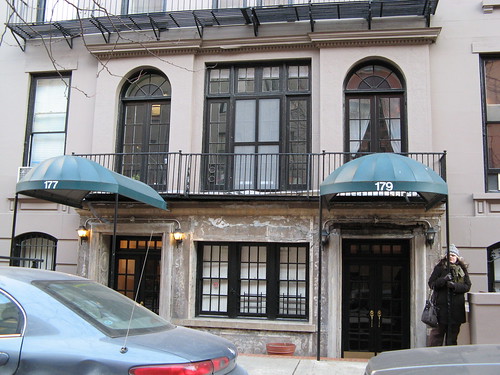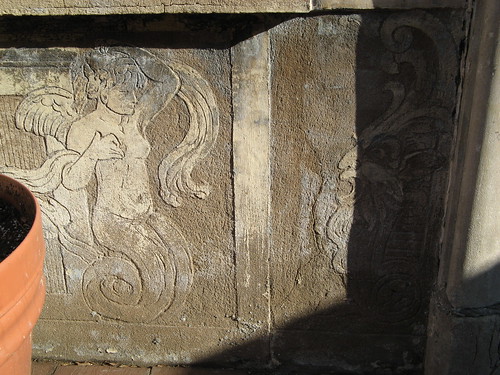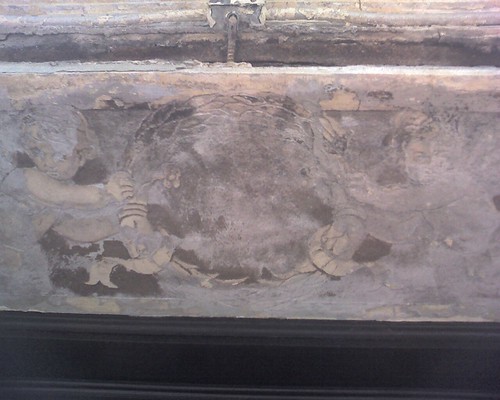Gargoyles, dolphins, sea nymphs…in Brooklyn? See them while you can, before they vanish into the past, victims of funding scarcity.
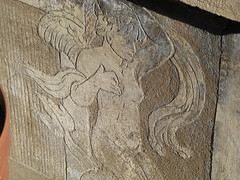
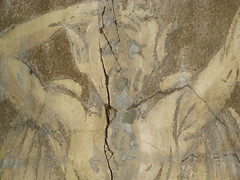
Details of the facade of 177-179 Columbia Heights. Click for larger images.
There’s an article in the Thursday March 1st edition of the “Brooklyn Heights Press & Cobble Hill News” by Phoebe Neidl about my new home, 177-179 Columbia Heights, and it’s strange and mysterious facade. Unfortunately the newspaper, a subsidiary of the Brooklyn Eagle, doesn’t have a web presence, so I cannot link to it directly. However, I will quote what I can. I urge you to seek it out. (Update: According to Ms. Neidl, the article has just been published in the Brooklyn Daily Eagle, so make sure to pick up a copy! It will also appear on their website, for those with access).
For reference, here’s how the building looks now (February 10th, 2007):
And here is how it looked in 1920:
1920 photo from the Brooklyn Public Library Digital Collection
The facade is an example of a very old art style called Sgraffito — layering a very light colored plaster onto a dark layer of plaster, then etching or scratching in the design (in a sense, it’s the rich uncle of graffiti and “street art“). It’s commonly found in the Bavaria region of Germany, Austria, the Czech Republic, and Italy. This particular facade is Italian in origin. Though the Brooklyn Heights Press’ headline calls them the “Devils of Brooklyn Heights”, they are actually gargoyles (or grotesques, technically):
“Some people call them devils,” [a resident said] “But I think they are more gargoyle-like, and gargoyles are there to protect you, so I prefer to think of them that way.”
The facade was discovered last year during a building-wide paint job. When a chemical paint remover was applied to the ground floor, it revealed this “most unusual facade treatment.” Art restorer Gabriel Popian of G &L Popian in Long Island City, who has helped to restore art and architecture throughout the world including the Vatican, examined the structure:
“It is a master technique”…”It’s very difficult to do. It’s very precise,” he said, crouched over inspecting what remained of the ochre paint detailing the fruit and flower motif. “It’s nothing commercial. It’s art.”
Usually, sgraffito is done on-site, however for this building the facade was made on pre-cast panels off-site, and then attached to the building. Who could’ve done it? The artist, an Italian immigrant, remains unknown, however there are clues to its origin. Built sometime in the 1860s, the building didn’t get the fanciful facade until the early 1900s, consequently when a substantial Italian conclave existed near the river and around Adams street. The Department of Buildings’ records state that several alterations were made in 1919, the year it was sold by Matilda Mygatt to Studio Apartment Company, Inc. According to the BH Press article, the most likely impetitus behind the sgraffito facade is Matilda’s son, Robertson Mygatt. An artist who had traveled to Europe, particularly through Italy, he was a member of several local artist organizations, and was “in a position to know many artists, and Italian artists at that.” He passed away in December 1919.
Sadly, ironically, the restoration of this Brooklyn Heights hidden gem is in jeopardy due to its cost:
…Part of the reason it has incurred so much damage is that the panels were not fused to the original facade of the building. The panels would have to be backed up with steel if the expensive restoration goes forward.
…
It’s so expensive they needed an estimate on the estimate,” said the building’s superintendent Steven Todorovich. And because it’s a co-op building in an affluent area, “it would be hard to find philanthropic groups that would fund it,” said [Alex Herrera of the New York Landmarks Conservancy group], adding, “My board wouldn’t fund it.”
Though I may be willing to subsist on nothing but Ramen Noodles to get the restoration completed, I don’t think nor expect others in the building to be that enthused (can’t really blame them either, I don’t think this is a typical Heights co-op). It would be a shame if this isn’t restored. In a neighborhood — in a city — full of architectural marvels and artistic achievements, this facade stands out as unique. There are few examples of this lost art on this side of the Atlantic, none as ornate as this. Not only a lost art, but a historical document of the first waves of Italian immigrants into this country. In this era of contentious war between those who want to preserve everything no matter how questionable its merit, and those who want nothing but giant glass boxes everywhere, who will champion this small rare find of fine Italian craftsmanship and artistry?
What do you think of the facade? Future Brooklyn Heights Association award winner? Or just another exhibit of the Forgotten NY museum?
All photos by World’s Worst Photographer in the World, except the BPL 1920 photo above. You can view the full set sgraffito photos as well.
